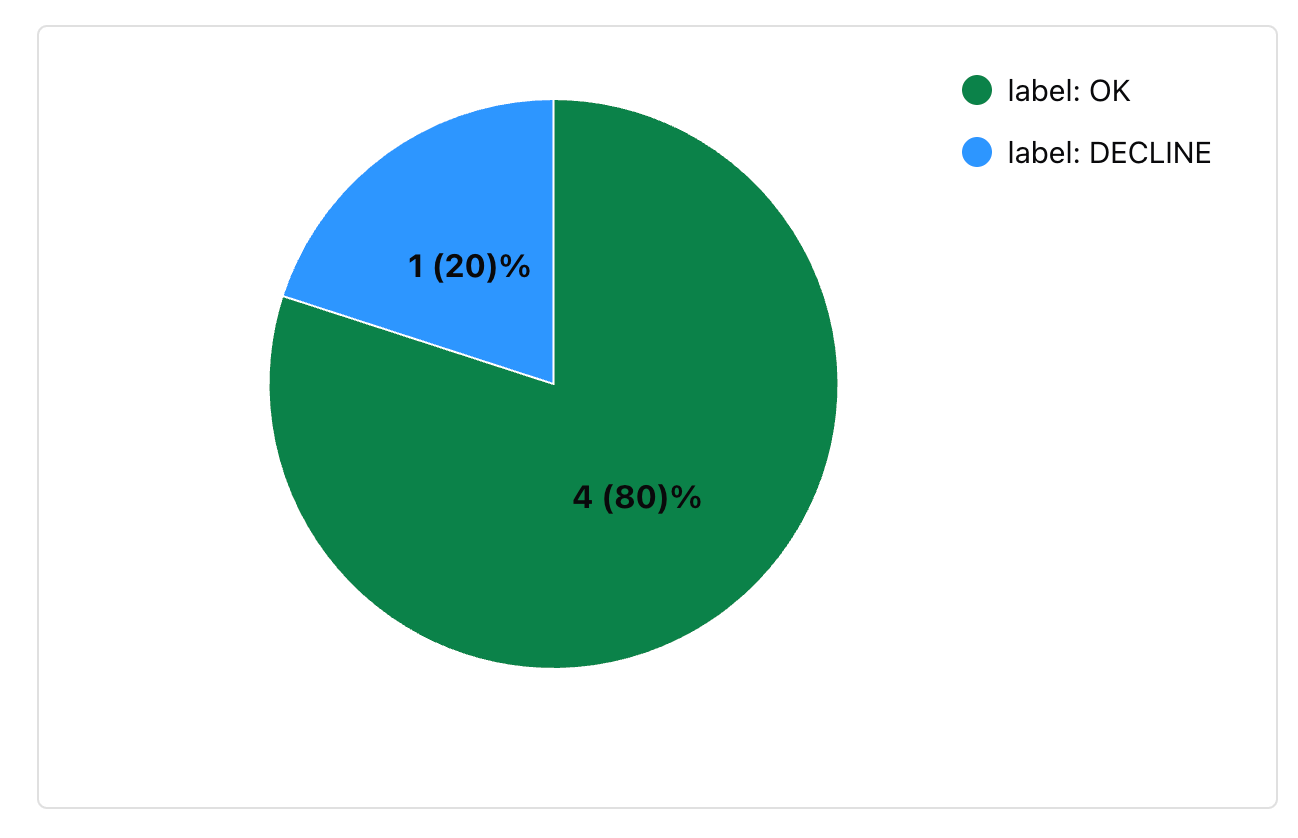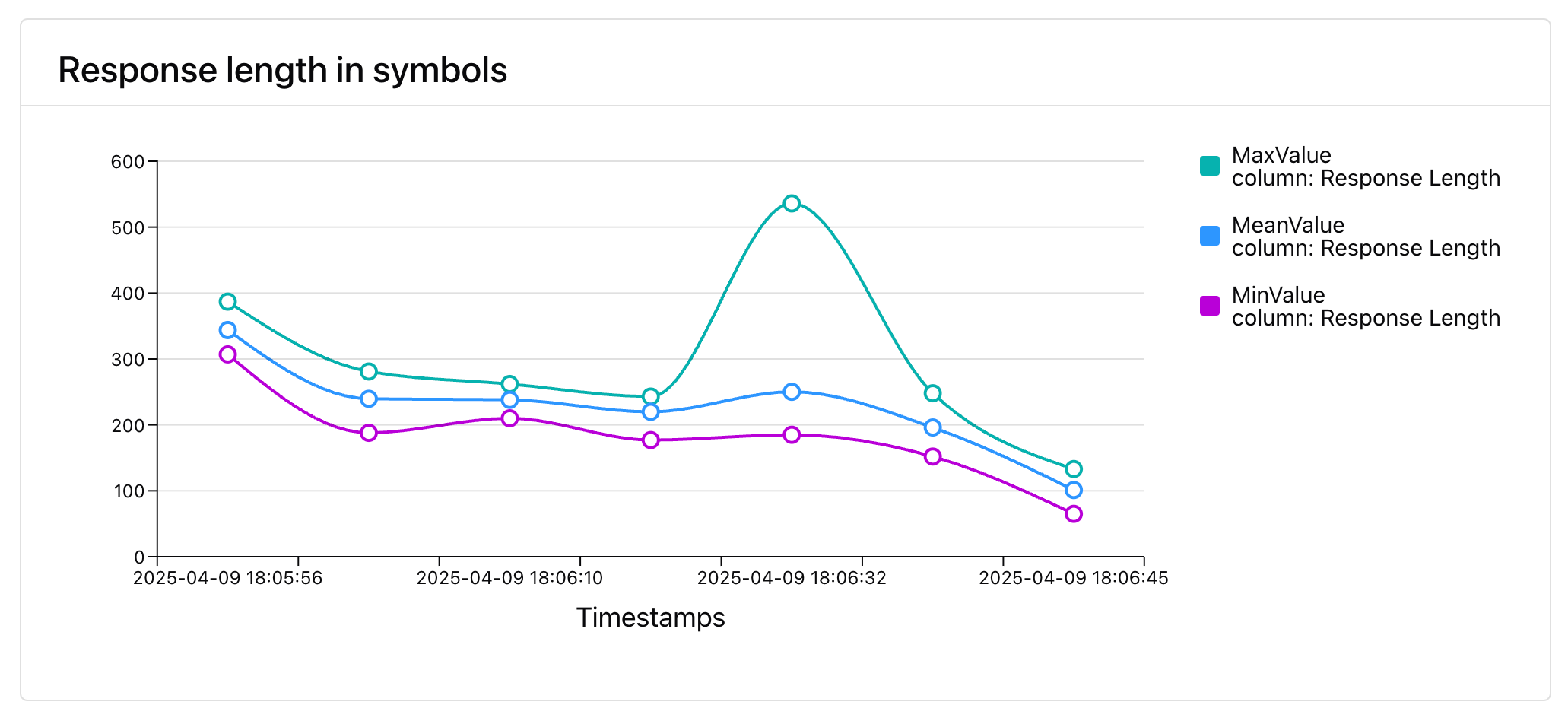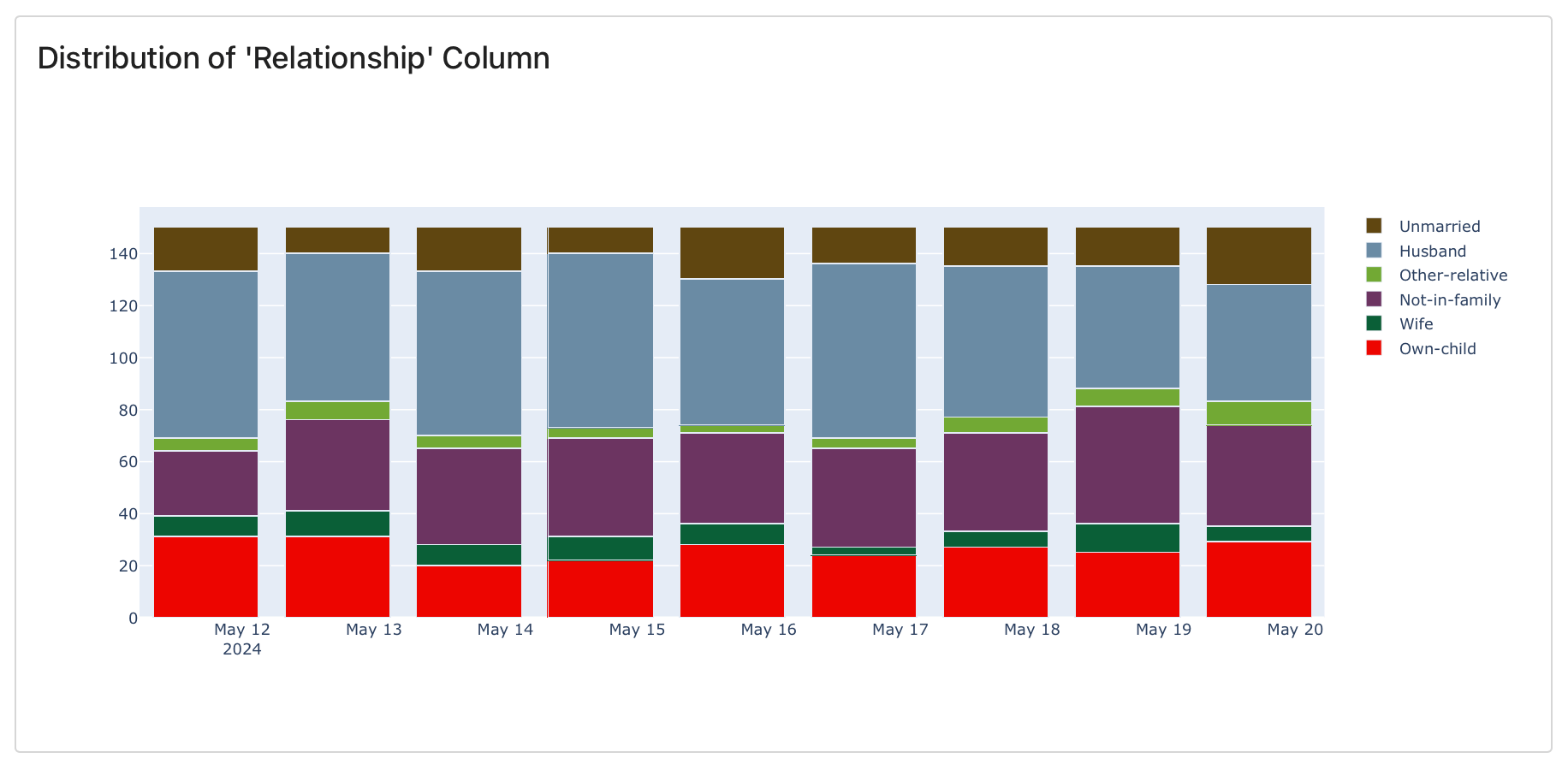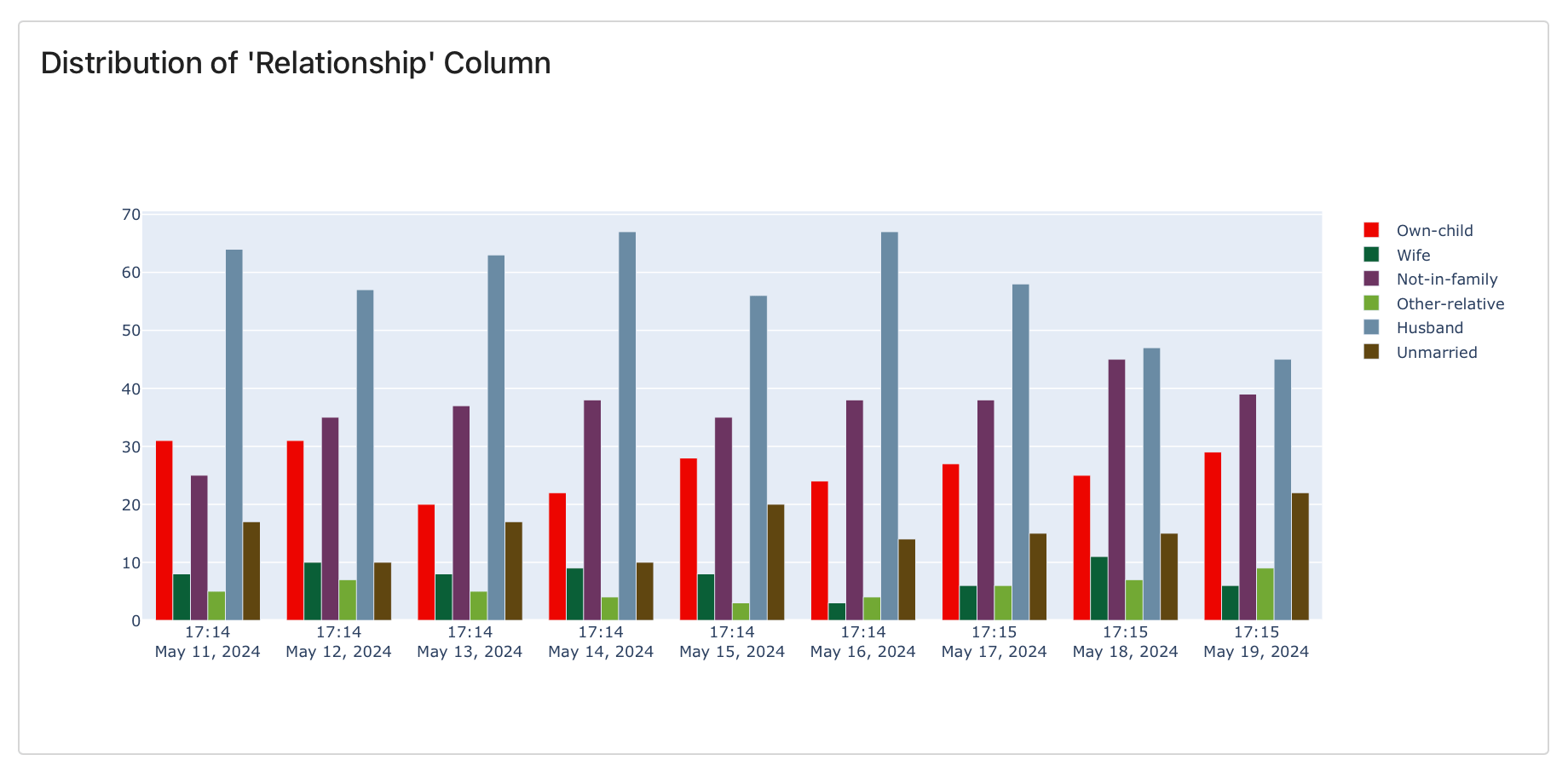You can add Panels in the user interface or using Python API. This pages describes the Python API. Check how to add panels in the UI.
Dashboard Management
Dashboards as code are available in Evidently OSS, Cloud, Enterprise.
project.dashboard.add_tab("Another Tab")
project.dashboard.delete_tab("Another Tab")
project.dashboard.delete_panel("Dashboard title", "My new tab")
project.dashboard.clear_dashboard()
Adding Panels
Imports:
from evidently.sdk.models import PanelMetric
from evidently.sdk.panels import DashboardPanelPlot
Text
Text-only panels are perfect for titles.
Add a text panel. Add a new text panel to the specified Tab.
project.dashboard.add_panel(
DashboardPanelPlot(
title="Dashboard title",
size="full",
values=[], #leave empty
plot_params={"plot_type": "text"},
),
tab="My new tab", #will create a Tab if there is no Tab with this name
)
Counters
Counter panels show a value with optional supporting text.

Text counter
Shows the specified value(s) and optional text.

Pie chart
Shows the specified value(s) in a pie chart.
RowCount metric with different aggregations:
# Sum
project.dashboard.add_panel(
DashboardPanelPlot(
title="Row count",
subtitle="Total number of evaluations over time.",
size="half",
values=[PanelMetric(legend="Row count", metric="RowCount")],
plot_params={"plot_type": "counter", "aggregation": "sum"},
),
tab="My tab",
)
# Average
project.dashboard.add_panel(
DashboardPanelPlot(
title="Row count",
subtitle="Average number of evaluations per Report.",
size="half",
values=[PanelMetric(legend="Row count", metric="RowCount")],
plot_params={"plot_type": "counter", "aggregation": "avg"},
),
tab="My tab",
)
# Last
project.dashboard.add_panel(
DashboardPanelPlot(
title="Row count",
subtitle="Latest number of evaluations.",
size="half",
values=[PanelMetric(legend="Row count", metric="RowCount")],
plot_params={"plot_type": "counter", "aggregation": "last"},
),
tab="My tab",
)
sum, last, avg).
project.dashboard.add_panel(
DashboardPanelPlot(
title="Row count",
subtitle="Total number of evaluations over time.",
size="half",
values=[PanelMetric(legend="Row count", metric="RowCount")],
plot_params={"plot_type": "pie", "aggregation": "sum"},
),
tab="My tab",
)
Plots
These Panels display values as bar or line plots.

Line chart
Shows the selected values over time. You can add multiple series to the same chart as multiple lines.

Bar chart (stacked)
Shows selected values or distributions over time (if stored in each Report). Stacked in a single bar.

Bar chart (grouped)
Shows selected values or distributions over time (if stored in each Report). Multiple bars.
RowCount metric.
# line chart
project.dashboard.add_panel(
DashboardPanelPlot(
title="Row count",
subtitle = "Number of evaluations over time.",
size="half",
values=[
PanelMetric(
legend="Row count",
metric="RowCount",
),
],
plot_params={"plot_type": "line"},
),
tab="My tab",
)
# bar chart
project.dashboard.add_panel(
DashboardPanelPlot(
title="Row count",
subtitle = "Number of evaluations over time.",
size="half",
values=[
PanelMetric(
legend="Row count",
metric="RowCount",
),
],
plot_params={"plot_type": "bar", "is_stacked": False}, #default False, set as True to get stacked bars
),
tab="My tab",
)
project.dashboard.add_panel(
DashboardPanelPlot(
title="Text Length",
subtitle="Text length stats (symbols).",
size="full",
values=[
PanelMetric(legend="max", metric="MaxValue", metric_labels={"column": "length"}),
PanelMetric(legend="mean", metric="MeanValue", metric_labels={"column": "length"}),
PanelMetric(legend="min", metric="MinValue", metric_labels={"column": "length"}),
]
)
)
Dashboard Panel options
A summary of all parameters:
| Parameter | Type | Required | Default | Description |
|---|
title | str | ❌ | None | Title of the panel. |
description | str | ❌ | None | Optional panel description shown as a subtitle. |
size | str | ❌ | "full" | Panel size: "full" (100% width) or "half" (50%). |
values | list | ✅ | — | List of PanelMetric objects to display. |
tab | str | ❌ | None | Dashboard tab name. If not set, defaults to the first tab or creates a new “General” tab. |
create_if_not_exists | bool | ❌ | True | If True, creates the tab if it doesn’t exist. Throws exception if False. |
plot_params | dict | ❌ | {} | Panel visualization settings like "plot_type": "text", "line", "counter". |
Configuring Panel values
Metric
To define which value the Panel displays, you must reference the name of the corresponding Evidently Metric. This metric must be present in the Reports logged to your Project. If the metric isn’t present, the Panel will appear empty.
Dataset-level Metrics: pass the Metric name directly to PanelMetric, e.g., "RowCount".
Example:
project.dashboard.add_panel(
DashboardPanelPlot(
title="Row count",
subtitle = "Number of evaluations over time.",
size="half",
values=[
PanelMetric(
legend="Row count",
metric="RowCount", ## <- metric name
),
],
plot_params={"plot_type": "line"},
),
tab="My tab",
)
TextEvals, ClassificationPreset, DataDriftPreset) contain multiple sub-metrics. When logging Reports using a Preset, you must reference the specific metric inside it, such as Accuracy, Recall, etc.
Metric labels
Some Metrics require additional context. This applies when the metrics:
- Operate at the column level
- Return multiple values (metric results)
- Have user-defined custom parameters
In these cases, use metric_labels to specify what exactly you want to plot.
Example. To plot the share of categories inside “Denials” column:
project.dashboard.add_panel(
DashboardPanelPlot(
title="Denials",
subtitle = "Number of denials.",
size="half",
values=[
PanelMetric(
legend="""{{label}}""",
metric="UniqueValueCount", # <- metric from TextEvals Preset that computes distinct values
metric_labels={"column": "denials", #column name
"value_type": "share" #metric result
}
),
],
plot_params={"plot_type": "bar", "is_stacked": True},
),
tab="My tab",
)
column label to specify which column or descriptor it refers to.
For example, in a TextEvals Report, each text descriptor (e.g., text length, LLM judged “denials”, etc.) is treated as a column. These descriptors are summarized with various statistics. To plot one of these values, you need to:
- Choose a summary Metric like
UniqueValueCount, MissingValueCount, MaxValue, etc.
- Use the
column label to point the specific descriptor.
Example. To plot the min value from the “Text Length” column:
values=[
PanelMetric(
legend="Min text length",
metric="MinValue", # <- metric from TextEvals Preset that computes min value
metric_labels={
"column": "TextLength", # <- target column name
}
)
]
value. For example, Accuracy returns the corresponding accuracy value. So listing just the Metric name is enough to specify what exactly you want to plot.
However, some metrics produce more than one metric result, like:
CategoryCount: returns both share and countMAE: returns both mean and std
In this case, you must point to which value you want using the value_type key, e.g. {"value_type": "share"}
values = [
PanelMetric(
legend="Share",
metric="DriftedColumnsCount", # <- metric from Data Drift Preset that returns `count` or `share` of drifting columns
metric_labels={"value_type": "share"} # <- plot relative share
),
]
How to verify the metric result for a specific metric?
- Look up the expected outputs in the All Metrics Table.
- Or, generate a Report with the target
metric and inspect its structure viareport.dict() or report.json().
metric_labels.
PanelMetric options
A summary of all parameters:
| Parameter | Type | Required | Default | Description |
|---|
legend | str | ❌ | None | Legend name in the panel. If None, one is auto-generated. |
tags | list | ❌ | [] | Optional tags to select values only from a subset of Reports in the Project. |
metadata | dict | ❌ | {} | Optional metadata to select values only from a subset of Reports in the Project. |
metric | str | ✅ | — | Metric name (e.g., "RowCount"). |
metric_labels | dict | ❌ | {} | Parameters like column names (applies to descriptors too) or value_type. |




